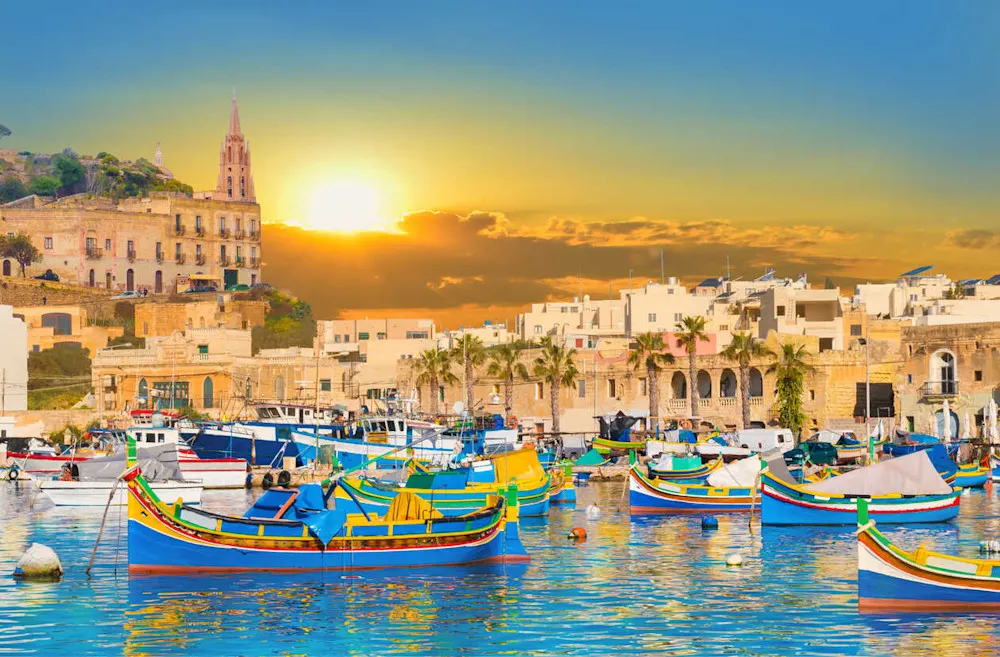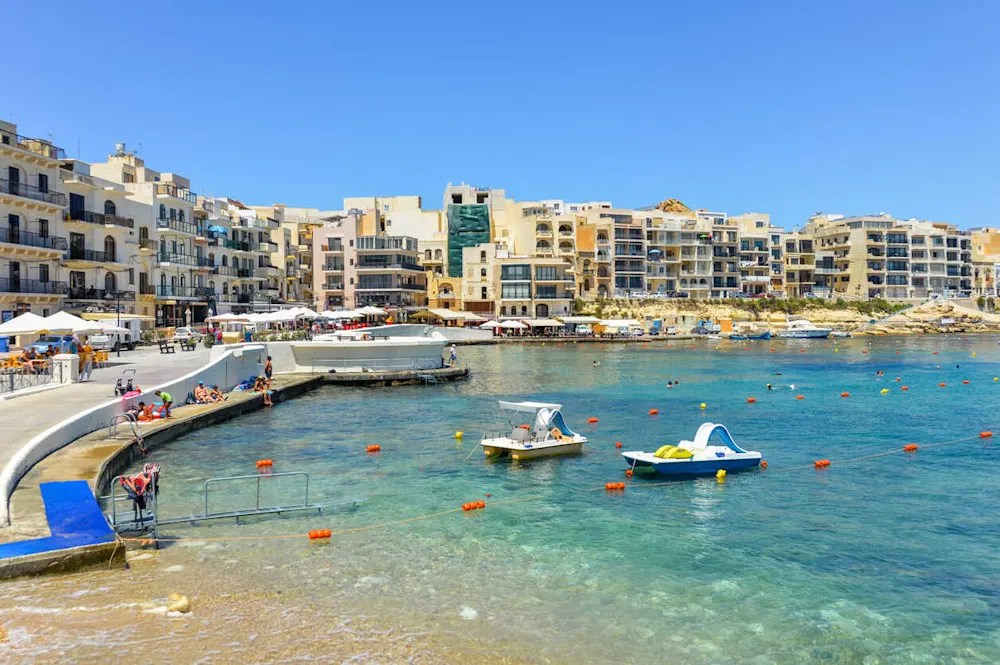The tiny, breathtaking island nation of Malta is one of the European Union’s most overlooked destinations for retirement—or even just a holiday. Malta (pop. approx. 560,000) is an archipelago in the central Mediterranean, between Sicily and the North African coast. Sitting at 36 degrees latitude, these islands offer some of the mildest winters in Europe (think: no snow) and a rich, layered history shaped by centuries of invasions. Within just 122 square miles (314 sq km), Malta boasts three UNESCO World Heritage sites—including its entire limestone-fortressed capital, Valletta.
Maintaining stable governance, minimal crime, and a lower cost of living than its northern neighbors, Malta checks many of the key boxes on an expat’s wish list. A former British protectorate, you’ll still find traces of the UK here—English as one of the official languages, red phone boxes, driving on the left, and systems (postal, electrical, and educational) modeled on Britain’s. It’s a remarkably safe corner of the Western world where living on—or under—$3,000 a month is still very achievable.
Across the islands, you won’t see a big difference in utility, grocery, or service costs thanks to Malta’s small size. But when it comes to housing and entertainment, choosing the right town can leave you with more spending money. The following spots—outside of the pricier Inner Harbour area—offer great value.
Get Your Free Malta Report Today
Get Your Free Malta Report Today
Discover why Malta is one of our favorite European destinations, sign up to International Living's free daily postcards and receive our FREE report: Malta: The Hidden Gem of the Mediterranean.
Get the latest info on properties, healthcare and visas based on our most recent research.

By submitting your email address, you will receive a free subscription to IL Postcards, Overseas Dream Home, The Untourist Daily and special offers from International Living and our affiliates. You can unsubscribe at any time, and we encourage you to read more about our Privacy Policy.
Mellieħa (pronounced meh-LEE-hah)

With a population of around 6,000, Mellieħa, located in the far north of Malta’s main island, is considered the quieter side of the country—especially during the off-season, when tourists and part-time residents thin out. Known for some of Malta’s most beautiful sandy beaches, Mellieħa is still just a 30 to 45-minute drive to Valletta or the international airport.
The town is built into the hills surrounding the bay, crowned by a towering limestone church that offers sweeping views in every direction. Winding roads descend toward the sea, flanked by weathered limestone walls and vibrant flowering plants, creating a striking contrast with the deep blue of the Mediterranean. Mellieħa Bay, also known as Għadira Bay, stretches for 2 kilometers and features golden sand, calm waters, and a protective inlet—making it one of the island’s best beaches for families. Seaside restaurants and umbrella-shaded loungers line the shore.
You can still find furnished two-bedroom, two-bath apartments in town for $950 to $1,000 per month. Expect to pay more for sea views. If you’re looking to buy property—and potentially use it as part of a residency application—the minimum purchase requirement outside the Inner Harbour area is €300,000 (about $309,000). That said, there are several properties in Mellieħa listed in the $250,000 to $300,000 range, within walking distance of the sea.
Dining out is affordable: dinner at an inexpensive restaurant averages $20, and a cold Cisk, Malta’s national beer, costs about $3. Utility bills are consistent island-wide, typically running between $150 and $200 per month. Public buses cost just €2.50 (€3 at night) and can take you anywhere on the island. Life on Malta’s quieter side comes with few compromises—and plenty of rewards.
Marsaxlokk (pronounced similarly to mar-sesh-lock)

Located in the far south of Malta’s main island, Marsaxlokk is one of the country’s last true fishing villages. This small seaside town of around 4,000 residents charms visitors with its colorful luzzus (traditional Maltese fishing boats) bobbing in the harbor and rows of historic limestone buildings lining the waterfront promenade.
The village remains peaceful during the week, with a modest daily market, but comes alive on Sundays when it hosts a bustling seafood, sundries, and crafts market. Restaurants fill with diners enjoying fresh catches just steps from the sea. It’s the best spot on the island to stock up on seafood—often at half the price of supermarket offerings. For example, lampuki (dorado) can sell for as little as €5 per kilo (about $2.27 per pound). It’s common to see locals and tourists alike drive from all over the country to take advantage of the deals.
Marsaxlokk is growing in popularity among expats seeking a quieter, less expensive lifestyle on Malta. You can find modern two-bedroom, two-bath furnished apartments for $900 to $1,000 per month. As the town becomes more “discovered,” new apartment buildings are popping up along the skyline. Even so, it’s still easy to find a brand-new two-bedroom, two-bathroom apartment for under €300,000 ($309,000). Utilities typically cost an additional $150 to $200 per month, depending on whether they’re included in your lease.
Meals out are affordable, too. Expect to pay around $20 per person at casual restaurants, or $35 at mid-range spots. Tipping isn’t customary in Malta, though leaving a few coins for good service is appreciated.
With an open-air market in town, grocery costs are lower than elsewhere. Many couples can comfortably budget $125 per week for groceries. And with money left over for food, healthcare, and travel, Marsaxlokk makes a compelling case for expat living with Mediterranean charm.
Gozo

If you’re looking to slow your pace of life even further, the island of Gozo—north of Malta and Comino—might be the perfect fit. Talk to anyone who’s lived in Malta for decades and they’ll say the same thing: Gozo feels like stepping back in time.
This is the rural side of Malta, with a rugged, untouched coastline, Baroque churches, traditional farmhouses, and spectacular diving spots. The water is impossibly clear—those brochure shots of aqua-blue waves you think must be photoshopped? That’s what it actually looks like.
Gozo is less developed than Malta and home to just 41,000 people. Around 6,600 of them live in the capital, Victoria, leaving plenty of open space across the island’s 26 square miles.
Furnished two-bedroom, two-bathroom apartments in Victoria typically rent for $900 to $1,000 a month. If you’re comfortable in a quieter town, you’ll find rental deals for as little as $450 a month—for instance, in the charming coastal village of Xlendi.
There’s no shortage of property for sale under $300,000. However, non-EU citizens applying for permanent residency through homeownership must purchase a property valued at €300,000 ($309,000) or more.
Living costs on Gozo are similar to Malta’s, though some staples (like groceries) may be slightly higher due to shipping logistics. Goods typically arrive from Europe by ferry to Malta, then are transported by truck and loaded onto the Gozo Channel Ferry. Healthcare is more limited on the island—there’s only a public hospital—so for major procedures or private care, you’ll need to go to Malta.
The standard return ferry fare for a car and driver is €15.70, though Gozo residents pay a reduced fare of €8.15.
Even with these minor adjustments, Gozo remains a peaceful, affordable haven where you can comfortably live on less than $3,000 a month.
Get Your Free Malta Report Today
Get Your Free Malta Report Today
Discover why Malta is one of our favorite European destinations, sign up to International Living's free daily postcards and receive our FREE report: Malta: The Hidden Gem of the Mediterranean.
Get the latest info on properties, healthcare and visas based on our most recent research.

By submitting your email address, you will receive a free subscription to IL Postcards, Overseas Dream Home, The Untourist Daily and special offers from International Living and our affiliates. You can unsubscribe at any time, and we encourage you to read more about our Privacy Policy.
